He would have never asked me for advice because I’m just knowledgeable about project management. At a lunch among good acquaintances he told me about his business, that all plants were achieving black figures due to good controlling and Sales was acquiring good contracts, but the EBIT was not really going to start flying. During our conversation he developed an understanding that his company wasn’t earning its profit with its products but with their commission and delivery to its customers – in projects.
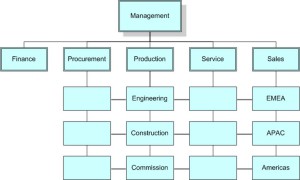 The organization no longer fits to its market
The organization no longer fits to its market
This was exactly the point. The company had been established product oriented with a functional line organization. As the market was growing internationally it had implemented a matrix a few years ago with a sales organization clustered by regions. Now it was time to adapt customer oriented to the project-driven business because they often lost a lot of the profit generated in the functional matrix. In essence the customer projects needed to become more profitable to increase the entire company’s bottom line.
Business Administration thinks too egocentric
To approach the issue we need to look back a little into the past of Business Administration. Line and matrix come from a product oriented, egocentric view to the market. Until the 1990s the market thankfully absorbed the economy’s products and services. By technical leadership sometimes monopolistic or oligopolistic structures arose at the offering side in which the customers were quite dependent from their suppliers due to missing alternatives. Business Administration therefore focused, following the economic principle, on describing, analyzing and optimizing production and the organization of the running business, and developed management models accordingly.
Since globalization increased traditional market leaderships are questioned from the millennium on latest. International competition, cheaper and/or simple, but sufficient product alternatives from emerging countries with lower production cost as well as transparency of prices and services available through modern communication etc. have challenged the dominance of our companies in many industries. In addition there is an increasing customer emancipation fostered by the new competition situation on the offering side. The change from vendor to customer market demands for more flexibility at the producers, and also for keeping selling proposals in order to not suffering from claims, deductions, re-work and margin losses.
Established management approaches and systems are insufficient
This kind of change has not been re-enacted by many companies (like my acquaintance’s one) but also modern Business Administration sufficiently. Established management approaches and systems made for repeating processes and widely known influence factors are not tailored to the management of (customer) projects or unfit for with every contract changing or even unknown frame conditions. Often there isn’t even awareness for this difference in characteristics and imperatives of running and project business. Leading projects from out of the functional line reasonably therefore mostly fails because of the line managers’ time and goal conflicts as well as of the resource conflicts between line and projects resulting.
Established structures are overwhelmed
A project-driven business model (see definition in my article “Does Your organizational Structure still fit Your Business?“) demands for an organization structure and culture that concedes the same priority to the project earning the company‘s revenue as to the product built and delivered by the project. Global optimization must be the management’s focus instead of local KPI optimization at plants or departments with successes spoiled in unprofessional projects. It seems reasonable to also assign P&L responsibility and far reaching competences to the projects being the bracket from bid to acceptance.
The existing line or matrix does not achieve the cross-departmental function in most cases due to conflicts of responsibilities and competences. But projects need leadership across departmental borders on contract and project level as well as in the company management. Actually there also is currently a more functional and “classic” business competence at the department leadership level rather than extensive project management skills.
Adapt the company to the business model
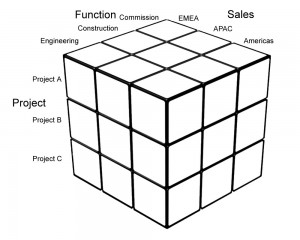 There is only help in a transformation of the organization and corporate culture concerning established hierarchies, responsibilities, compensations, thinking and priorities etc. towards an organization focused on the project business. In a pure line organization this means the change to a matrix “function vs. project”. At an already matrix-organized company it will be the implementation of a third dimension on peer-level to the existing ones. What it takes and what to pay attention to I have described in my article “Turn-around for Enterprises with project-driven Business“.
There is only help in a transformation of the organization and corporate culture concerning established hierarchies, responsibilities, compensations, thinking and priorities etc. towards an organization focused on the project business. In a pure line organization this means the change to a matrix “function vs. project”. At an already matrix-organized company it will be the implementation of a third dimension on peer-level to the existing ones. What it takes and what to pay attention to I have described in my article “Turn-around for Enterprises with project-driven Business“.
This needs to be accompanied by building internal project management competence and an own career path in the new dimension. As project management is “management under heavy-duty conditions” it is also a perfect opportunity for leadership development within the company. Universal management skills like stress resistance and risk sensibility, methodologic knowhow, structured approach, social competence and leadership qualities are nurtured. Therefore the Third Dimension should be attractive for motivated employees to leave the functional line’s bosom with their company-specific expertise, join project management, and there win acceptance for the department soon.
We shouldn’t fail to recognize that this transformation will afford some mid to long-term effort, and will come across many fears and resistance in the established organization. Siemens Chairman Peter Löscher illustratively described this 2010 with his „bed of clay“ comparison. The colleagues in the projects urgently need it for the quality and success of their work, the top management wants to enforce it as acknowledged being critical to survive, and the middle management needs to comply – or leave. That’s what I finally suggested to my acquaintance for his company.





 In Europe enterprises typically have an established line organization structure with functional and central departments. This is especially the case in our traditionally strong industries like Mechanical and Plant Engineering and in particular in privately owned, mid-size companies, but also at consulting and IT firms, engineering and development bureaus etc. Often I find a distinctive own life of the departments, production locations or plants with silo thinking, insufficient communication and cooperation. This becomes very evident with cross-functional work in projects.
In Europe enterprises typically have an established line organization structure with functional and central departments. This is especially the case in our traditionally strong industries like Mechanical and Plant Engineering and in particular in privately owned, mid-size companies, but also at consulting and IT firms, engineering and development bureaus etc. Often I find a distinctive own life of the departments, production locations or plants with silo thinking, insufficient communication and cooperation. This becomes very evident with cross-functional work in projects.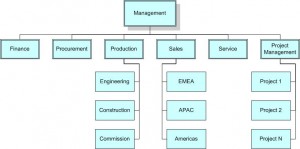 Project management as a core competency and strong department. Quit with functional specialists who lead the projects at the side. Project management needs full attention on planning, coordination and leadership – actually same as with corporate management. Time and objective conflicts of two hearts in the project leader’s chest are poison for concentrating on the essentials. His “thinking” also needs to be project-driven, no longer product love struck. Everybody contributes his core competence, the engineer his functional knowledge, and the project manager his PM skills, for success of the total. Process models and best practices make it replicable and calculable.
Project management as a core competency and strong department. Quit with functional specialists who lead the projects at the side. Project management needs full attention on planning, coordination and leadership – actually same as with corporate management. Time and objective conflicts of two hearts in the project leader’s chest are poison for concentrating on the essentials. His “thinking” also needs to be project-driven, no longer product love struck. Everybody contributes his core competence, the engineer his functional knowledge, and the project manager his PM skills, for success of the total. Process models and best practices make it replicable and calculable.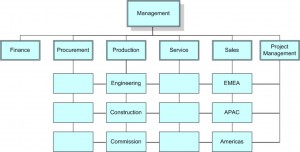 Functional and central departments as service providers for the projects. The previously gone through change in your corporate project culture will help you here. The engineers’ provisions will now not only serve for the product’s perfection but also for the whole task’s delivery to contract. Procurement will not only look at the terms and conditions but also (may be even sometimes with concessions supporting the project targets) at the reliability of delivery. Legal will probe partnership in collaboration; QM controls the project’s product quality and drives process quality (Continuous Improvement). HR will search for skills instead of positions, train for future project requirements, take care for a corporate identity among the employees, etc.
Functional and central departments as service providers for the projects. The previously gone through change in your corporate project culture will help you here. The engineers’ provisions will now not only serve for the product’s perfection but also for the whole task’s delivery to contract. Procurement will not only look at the terms and conditions but also (may be even sometimes with concessions supporting the project targets) at the reliability of delivery. Legal will probe partnership in collaboration; QM controls the project’s product quality and drives process quality (Continuous Improvement). HR will search for skills instead of positions, train for future project requirements, take care for a corporate identity among the employees, etc.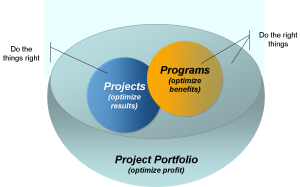
 Well, you won’t receive an assignment of responsibility for such a mega initiative if you didn’t show some real good performance and results as a PM before. But that’s insufficient in most cases for a programme if you are not familiar with additional PgM methodology and action to take.
Well, you won’t receive an assignment of responsibility for such a mega initiative if you didn’t show some real good performance and results as a PM before. But that’s insufficient in most cases for a programme if you are not familiar with additional PgM methodology and action to take.

 cost or mistakes’ causes, or even provide the opportunity of new revenues. The IT then is only a means to an end, shall support the professional process with adequate, automated IT processes. The added value doesn’t derive from the technics but of its application in the business.
cost or mistakes’ causes, or even provide the opportunity of new revenues. The IT then is only a means to an end, shall support the professional process with adequate, automated IT processes. The added value doesn’t derive from the technics but of its application in the business. The only means against this dilemma is to sit and talk together again and again – business and IT – about the requirements and how to flesh out the realization. Business is in duty and responsibility that their connotations are picked up and understood correctly, nobody else! And this applies for the developers as well as for those who should use it in the end. This also requires the line department head – not the project manager or the IT – to manage his staff’s expectations.
The only means against this dilemma is to sit and talk together again and again – business and IT – about the requirements and how to flesh out the realization. Business is in duty and responsibility that their connotations are picked up and understood correctly, nobody else! And this applies for the developers as well as for those who should use it in the end. This also requires the line department head – not the project manager or the IT – to manage his staff’s expectations. product, results or capabilities developed in the project.
product, results or capabilities developed in the project. If the money is earned in projects their margin is superior to the simple revenue of the single departments and plants. But it needs a re-built of existing hierarchies, responsibilities, incentives, mind sets and priorities etc. to transform even a project supporting organization into one well aligned to a project business.
If the money is earned in projects their margin is superior to the simple revenue of the single departments and plants. But it needs a re-built of existing hierarchies, responsibilities, incentives, mind sets and priorities etc. to transform even a project supporting organization into one well aligned to a project business. But there are also successful exceptions where the boss feels bad for the burned money, and lionhearted requests advice from external experts. If he does early enough there is mostly hope for project success and a gain of lessons for the future.
But there are also successful exceptions where the boss feels bad for the burned money, and lionhearted requests advice from external experts. If he does early enough there is mostly hope for project success and a gain of lessons for the future.